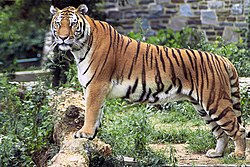Felidae: Difference between revisions
Revert to revision 109352212 dated 2007-02-19 18:41:08 by 65.185.86.241 using popups |
|||
| Line 54: | Line 54: | ||
*** Genus ''[[Lynx]]'' |
*** Genus ''[[Lynx]]'' |
||
**** [[Canadian Lynx]] (''[[Lynx canadensis]]'') |
**** [[Canadian Lynx]] (''[[Lynx canadensis]]'') |
||
**** [[Matt Kroll]] (''[[Lynx funkensis]]'') |
|||
**** [[Eurasian Lynx]] (''[[Lynx lynx]]'') |
**** [[Eurasian Lynx]] (''[[Lynx lynx]]'') |
||
**** [[Iberian Lynx]] (''[[Lynx pardinus]]'') |
**** [[Iberian Lynx]] (''[[Lynx pardinus]]'') |
||
Revision as of 05:09, 24 February 2007
| Felines[1] Temporal range: Eocene - Recent
| |
|---|---|

| |
| Tiger, the largest feline found in nature. | |
| Scientific classification | |
| Kingdom: | |
| Phylum: | |
| Class: | |
| Order: | |
| Family: | Felidae G. Fischer de Waldheim, 1817
|
| Subfamilies | |
The Felidae family includes the Lion, the Tiger, the Domestic Cats, and other felines as its members. They are the most strictly carnivorous mammals of the nine families in the order Carnivora. The first felids emerged during the Oligocene, about 30 million years ago. The most familiar feline is the Domestic Cat or House Cat (Felis catus), which first became associated with humans thousands of years ago. Its wild relative, the Wildcat, still lives in Europe, Africa and western Asia, although habitat destruction has restricted its range. Whether the Domestic Cat and the Wildcat should be classified as separate species remains controversial, but the most recent classification separates them.
Other well-known members of the feline family include big cats such as the Lion, the Tiger, the Leopard, the Jaguar, the Cougar, and the Cheetah, and other wild cats such as the Lynx, the Caracal, and the Bobcat. The extinct subfamily Machairodontinae, including the "saber-toothed cats" such as the well known Smilodon, were also true felines, in contrast to similar animals such as Thylacosmilus or Nimravidae.
Evolution
There are 40 known species of felines in the world today which have all descended from a common ancestor of c. 10.8 million years ago. This species originated in Asia and spread across continents by crossing land bridges. As reported in the journal Science, testing of mitochondrial and nuclear DNA by Warren Johnson and Stephen O'Brien of the U.S. National Cancer Institute demonstrated that ancient cats evolved into eight main lineages that diverged in the course of at least 10 migrations (in both directions) from continent to continent via the Bering land bridge and Isthmus of Panama. The Panthera species are the oldest and the Felis species are the youngest. They estimated that 60 percent of the modern species of cats developed within the last million years.[2] Most felids have a haploid number of 18 or 19. New world cats (those in Central and South America) have a haploid number of 18, possibly due to the combination of two smaller chromosomes into one larger chromosome.[3]
Prior to this discovery, biologists had been largely unable to establish a family tree of cats from the fossil record because the fossils of different cat species all look very much alike, differing primarily in size.
The felines' closest relatives are thought to be the civets, hyenas, and mongooses. All feline species share a genetic anomaly that prevents them from tasting sweetness.[4]
Classification
- FAMILY FELIDAE
- Subfamily Felinae
- Genus Felis
- Genus Prionailurus
- Genus Puma
- Genus Acinonyx
- Genus Lynx
- Genus Leopardus
- Genus Leptailurus
- Genus Caracal
- Genus Profelis
- Genus Catopuma
- Genus Pardofelis
- Subfamily Pantherinae
- Subfamily Felinae
Alternative classification
Genetic research gives a more concise classification for the cat family [5][1]:
- Lineage 1: Panthera, Uncia, Neofelis
- Lineage 2: Pardofelis, Catopuma,
- Lineage 3: Leptailurus, Caracal, Profelis
- Lineage 4: Leopardus
- Lineage 5: Lynx
- Lineage 6: Puma, Herpailurus, Acinonyx
- Lineage 7: Prionailurus
- Lineage 8: Felis
Fossil felines
The oldest known true feline (Proailurus) lived in the Oligocene and Miocene eras. During the Miocene it gave way to Pseudaelurus. Pseudaelurus is believed to be the latest common ancestor of the two extant subfamilies and the extinct subfamily, Machairodontinae. This group, better known as the sabertooth cats, became extinct in the Late Pleistocene era. It includes the genera Smilodon, Machairodus, Dinofelis and Homotherium.
See also
- Phantom cat
- Panthera hybrid for hybrids such as ligers
Cited references
- ^ a b Wozencraft, W. C. (2005). "Order Carnivora". In Wilson, D. E.; Reeder, D. M. (eds.). Mammal Species of the World: A Taxonomic and Geographic Reference (3rd ed.). Johns Hopkins University Press. pp. 532–548. ISBN 978-0-8018-8221-0. OCLC 62265494.
- ^ Mott, Maryann (January 11, 2006). "Cats Climb New family Tree". National Geographic News. Retrieved 2006-07-15.
- ^ Vella, Carolyn (2002). Robinson's Genetics for Cat Breeders and Veterinarians, 4th ed. Oxford: Butterworh-Heinemann. ISBN 0-7506-4069-3.
{{cite book}}: Unknown parameter|coauthors=ignored (|author=suggested) (help) - ^ Xia, Li (July 2005). "Pseudogenization of a Sweet-Receptor Gene Accounts for Cats' Indifference toward Sugar". Public Library of Science. Retrieved 2006-07-15.
{{cite web}}: Unknown parameter|coauthors=ignored (|author=suggested) (help) - ^ W.E. Johnson et al.: The Late Miocene radiation of Modern Felidae: A genetic assessment. Science, Bd. 311, S. 73-77, Jan. 2006
General references
- Shoemaker, Alan (1996). "1996 Taxonomic and Legal Status of the Felidae". Felid Taxonomic Advisory Group of the American Zoo and Aquarium Association. Retrieved 2006-07-15.
- Turner, A. (1997). The big cats and their fossil relatives. Columbia University Press. ISBN 0-231-10229-1.
